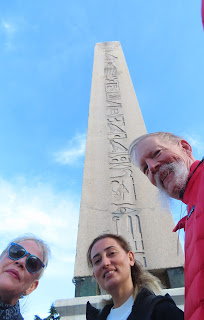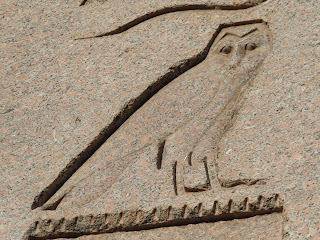The Hippodrome Square is not a Hippodrome anymore. It was once a huge horseshoe shaped arena that housed chariot races, gladiatorial fights, animal battles and the like. Built in 203 CE before the split of the Roman empire when the town was still called Byzantium. It was huge 1400 feet long and almost 500 feet wide. It had two levels of galleries and the seating capacity was a staggering 100,000! There were two chariot racing teams the blues and the greens that competed here and it was a fierce rivalry. These races were so important to the people that when a race was disrupted by a protest of high tax rates in 532 CE, a riot broke out. These riots were the mother of all riots and they lasted for three days. Most of the important building were burned down or damaged in some way including the Hagia Sophia and the Byzantine Cathedral. Roman forces came to quell the violence with....more violence! 30,000 people were rounded up into the Hippodrome and slaughtered by the soldiers. The fourth crusade came into town in 1204 and took over. They used the city for a launching point for assaults on Jerusalem. In that time they looted many of the artifacts that were decorating the Hippodrome and took the entire top level of the galleries. The bronze four horses statue that were on the top of the gates of the Hippodrome is now in Venice. In addition the bronze cladding of the 32.5 meter tall Walled Obelisk was removed. The bronze plates were bronze with a gold coating and the crusaders may have thought they were solid gold. The hippodrome fell into disrepair after his and many of the columns were taken away and reused in building of nearby mosques. To some extent, turn about is fair play as the remaining items in the Hippodrome Square were themselves looted from elsewhere. There is the bronze Serpent Column snatched from the Apollo Temple in Delphi Greece and the Obelisk of Thutmose III built in 1490 BC and snatched from Karnak. This obelisk was brought to Constantinople in 390 CE by Theodosius the Great. Unfortunately it was so large that there were no ships big enough to transport it. To solve this problem, they cut 13 or so meters off of the base taking the 32.5 meter granite obelisk down to only 19 meters. It is set on a carved marble base with four large bronze cubes supporting the obelisk. It took the Emperor's engineers 30 days to figure out how to erect the obelisk.
This mighty granite obelisk has stood on this spot since 390 CE. It was carried up the hill by the slaves and it sat at the top of the hill for 30 days before they were able to erect it.
Owl you doing?
These hieroglyphs look like a face
The base is very large in and of itself. Here is the Emperor, his council and commoners all watching the chariot races at the Hippodrome
The marble base it richly carved
Roman script is on one side
Greek script on the other
This is a vertical rain drainage system
This shows the system of pulleys used to erect the obelisk
Sturdy ropes were used
This shows the engineers and the erected obelisk
Council members
Everybody who was everybody wanted to get their faces on the base
Here were spectators with their fists up in the air
Watching the chariot races
Dancers showing their moves
It was amazing the details that have survived
The bronze cubes have been attributed to keeping the obelisk standing during earthquakes
The serpent column snatched from Delphi
It was two snakes intertwined and the bronze snakes had heads on the top that supported a big bronze bowl. It was converted into t fountain that dispensed water. On holidays it could be converted over to dispensing wine or milk
The walled obelisk is now just stones. There are holes in the stones where the bronze plates were attached
See the holes!























